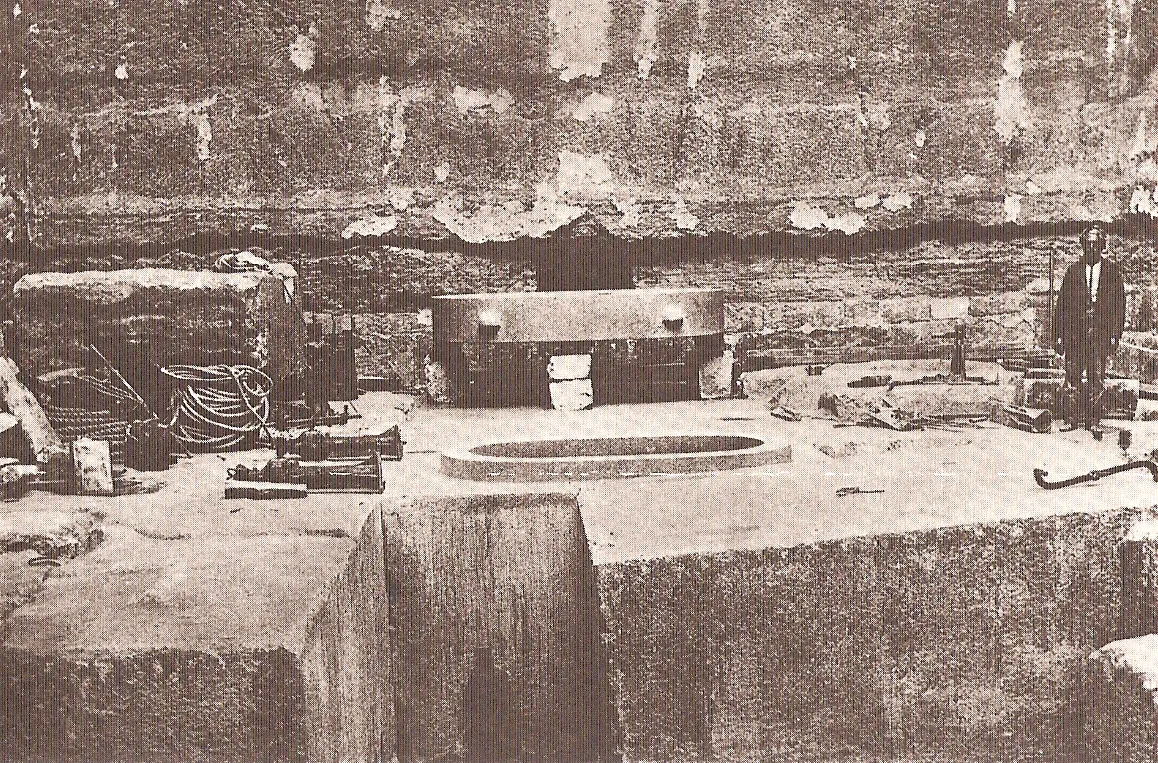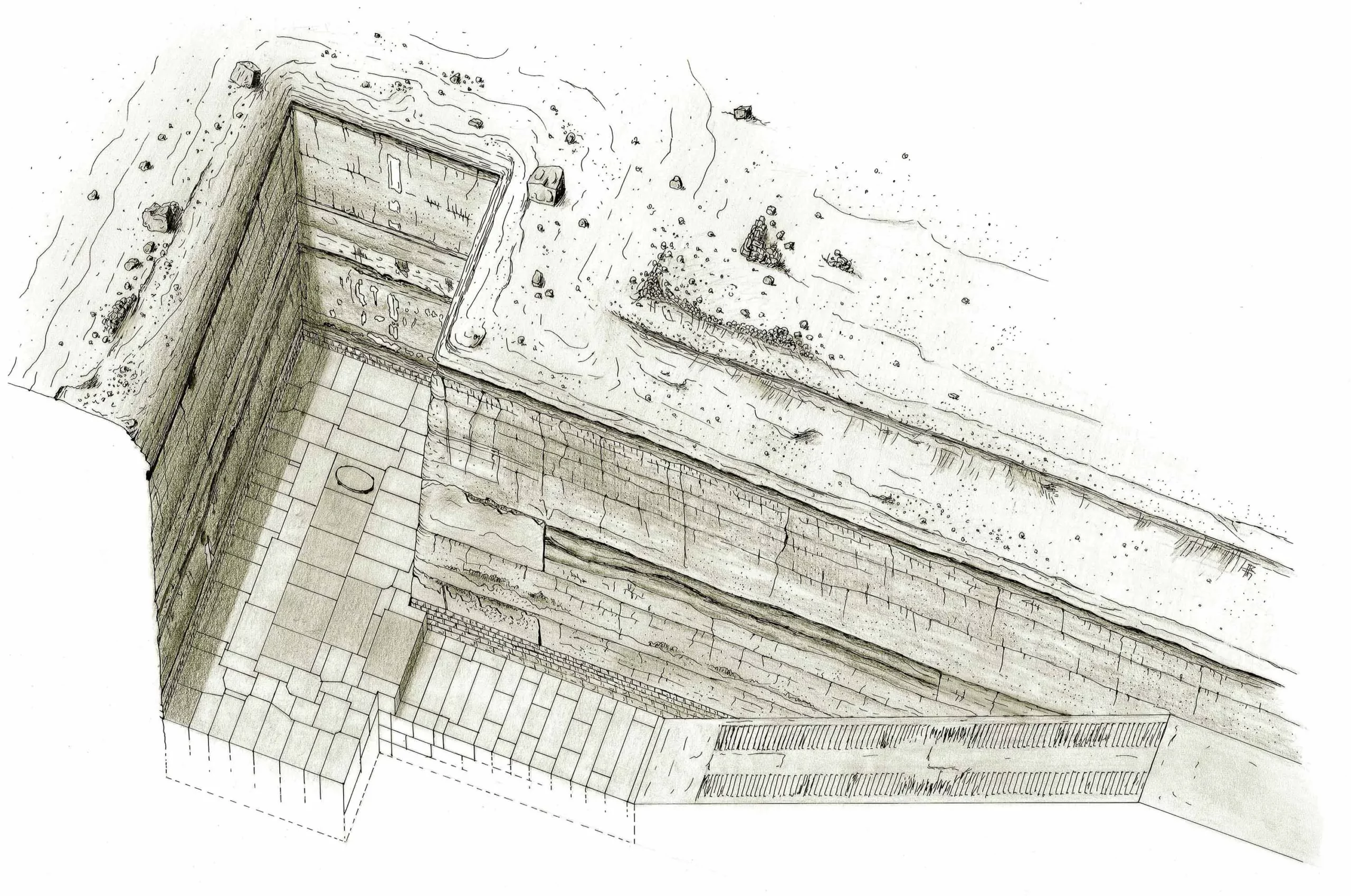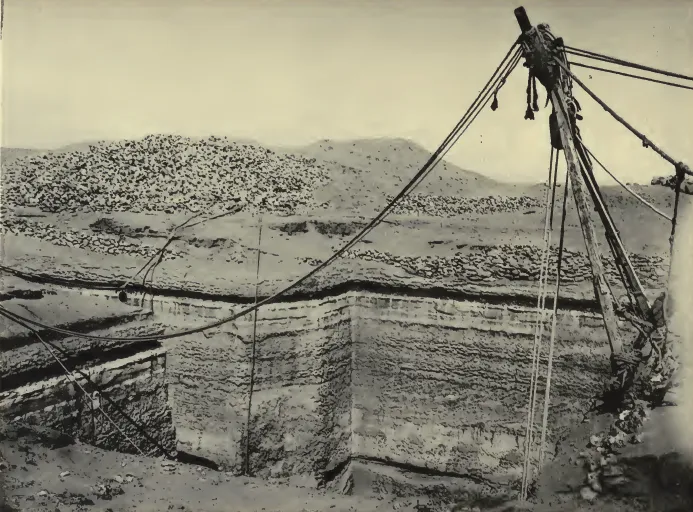The Northern Pyramid of Zawyet el-Aryan, also known as the Pyramid of Baka and Pyramid of Bikheris, is a massive, unfinished pyramid located at Zawyet el-Aryan in Egypt. Its ownership is uncertain, but most Egyptologists believe it belonged to a king known under his Hellenized name, Bikheris, although some scholars dispute this dating.
Get your dose of History via Email
Location
The Baka pyramid is situated in the northern sector of Zawyet el-Aryan, approximately 8 km southwest of Giza, within a modern military restricted area.
Early Excavations
The first excavations and descriptions were conducted between 1842 and 1846 by German Egyptologist Karl Richard Lepsius, who marked it as Pyramid XIII. Between 1905 and 1912, Italian archaeologist Alessandro Barsanti further examined the pyramid shaft.
World War I and Resumption of Excavations
Excavations were halted during World War I and resumed in 1954 for the film “Land of the Pharaohs,” directed by Howard Hawks. The film production required the landscape to be cleared of sand and rubble.

Military Restrictions and Current Status
Since 1964, the Baka pyramid has been within a military restricted area, preventing further excavations. The original necropolis has been overbuilt with military bungalows, and the shaft is now used as a local dump. Consequently, the current status of the burial shaft is uncertain and likely in poor condition. This has prompted social media videos and posts calling this “Egypt’s area 51”.
Superstructure
Next to nothing is known about the superstructure of the Northern Pyramid of Zawyet el-Aryan. Only the quadratic base, made of natural bedrock, was completed. It measures 200 x 200 meters. Traces of a surrounding pedestrian area, preserved for the limestone covering, can still be seen. If the pyramid was planned with a 52° slope, like the Khufu pyramid, it would have been close in size to the Khafre pyramid. The exact planned size and slope are unknown as no covering blocks were found.
Substructure
The substructure consists of a T-shaped burial shaft. The passage is oriented south to north, and the burial chamber is oriented east to west. The shaft has no ceiling and might never have had one. A steep stairway leads down to the burial chamber. The stairway is interrupted halfway by a horizontal landing of unknown purpose. The burial chamber, although never finished, has smooth shaft walls but no stone covering. Only the floor was completed. It was covered with massive granite blocks, each measuring 4.5 meters long, 2.5 meters thick, and weighing up to 9 tons.

Sarcophagus
An unusual oval sarcophagus was found embedded into one of the floor blocks. It measures 3.15 meters long, 2.22 meters wide, and 1.50 meters deep, with its lid found in situ and sealed. According to Barsanti, traces of a burial were found inside but were never examined and are now lost. Barsanti also claimed to have found a damaged dedication tablet with the name of King Djedefre.
Pyramid Complex
The pyramid complex included a 465 x 420 meter enclosure wall, with the necropolis alignment similar to that of the Djedefre pyramid. The necropolis was left unfinished, with no traces of a mortuary temple, causeway, valley temple, or other cultic buildings.
Debates on the Pyramid’s Date
Egyptologists and historians actively debate the pyramid’s date. Graffiti found in the burial chamber and passage name different workmen’s crews and the planned necropolis: Seba[-weref] ?-Ka ([great] star of ?-Ka). These inscriptions mention the name Nebkare (Lord of the Ka of Re), possibly referring to a king or prince. Additionally, another inscription mentions a possible Gold name: Neb hedjet-nwb (Lord of the Golden Crown), which some scholars propose as the Horus name of King Huni or the Gold name of King Nebka.
Cartouche Name Interpretations
Several scholars offer alternative readings of the cartouche name found in six ink inscriptions. Kurt Sethe reads it as Nebka (His Ka is the Lord). Meanwhile, Jean-Philippe Lauer interprets it as Bik-Ka (His Ka is Divine). Peter Kaplony suggests it reads Schena-Ka (His Ka is Forceful), and Gaston Maspero sees it as Nefer-Ka (His Ka is Beautiful). Wolfhart Westendorf suggests it depicts a giraffe, an animal considered wise and possessing shamanistic powers.
Theories on Ownership
Jürgen von Beckerath and George Reisner believe the pyramid was intended for Prince Baka, son of King Djedefre. They theorize he possibly changed his name to Bakare (Soul and Ka of Re) upon ascending the throne but died unexpectedly. On the other hand, Aidan Dodson reads the name as Seth-Ka (Seth is My Ka) and believes the pyramid was for Prince Setka, another son of Djedefre. Both theories place the tomb’s date in the 4th dynasty.
Alternative Dating Theories
Alternatively, Kurt Sethe, Nabil M.A. Swelim, and Wolfgang Helck argue for a late 3rd dynasty date. They note the use of hewn granite in royal tombs since King Khasekhemwy’s reign and the tradition of shaft-like tombs beneath pyramids during the 3rd dynasty. Moreover, they question Barsanti’s measurements and doubt the authenticity of Djedefre’s dedication tablet.
Period: Late 27th century BC to early 26th century BC
Sources:

